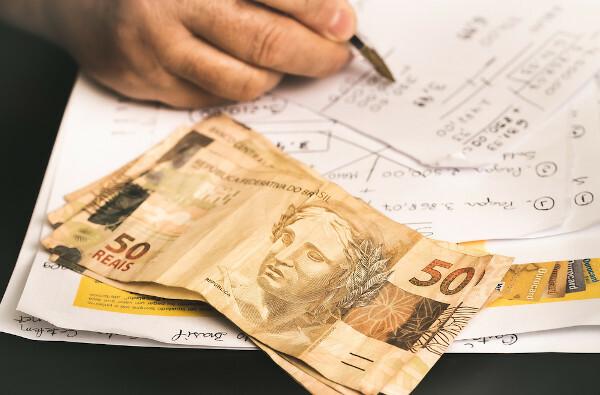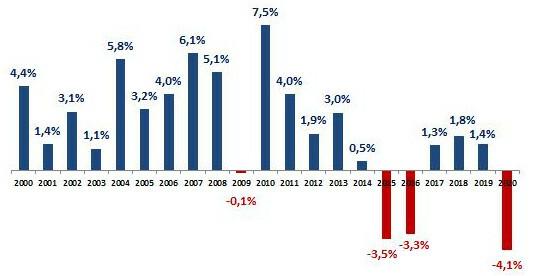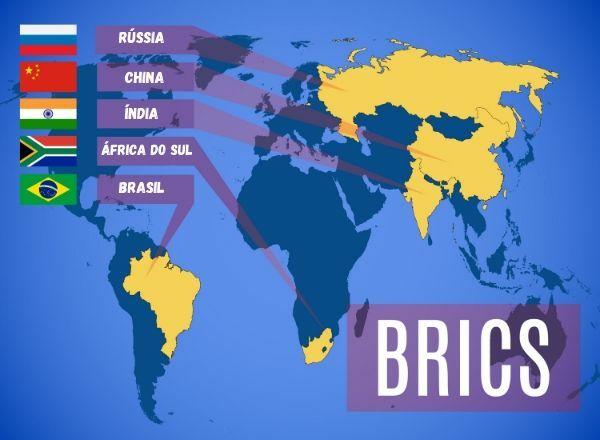O Brazil's GDPis currently BRL 7.4 trillion. The calculation of this indicator is carried out by the Brazilian Institute of Geography and Statistics (IBGE) and takes into account all services and final goods produced in the country during a period of time, which is usually one year or three months, which may vary.
Read too: Brazil: underdeveloped or emerging?
How is Brazil's GDP calculated?
The calculation of Gross Domestic Product (GDP) IBGE is periodically published by the IBGE, which also disseminates it. IBGE calculates Brazil's GDP from various territorial levels and the data are available for public consultation.
To reach the final value of GDP, IBGE takes into account the amount, in reais, of all services and goods that are produced by the country (or determined territorial area) in a period of time. This time is usually one year or three months, which is important to have a detailed picture of the evolution of the Brazilian economy, making the situational analysis more effective.

As a way to prevent the same amounts from being accounted for more than once, the IBGE reinforces that only final goods and services are considered in the GDP calculation, that is, the raw materials used in the manufacture of a certain object, for example, are not considered, only the product in its finished form. Thus, GDP can be calculated from supply (or wealth), demand and income.
The offer consists of the sum of all production in the country in a previously delimited period of time. This production comes from the three sectors of the economy: primary, related to agriculture; secondary, to industry; and tertiary, which brings together trade and services. As highlighted above, only the final products are considered for calculation purposes, thus avoiding the duplication of values.
Demand is about consumption, both of families and of the government, and the expenses made, which are related to government expenses in general, the balance of trade and investments made by companies.Income, in turn, is expressed by the sum of remuneration and income, which represents thes wages paid to workers, interest, company profits and rents.
IBGE uses both its own data and data produced by other agencies to compose the GDP. The publication of results always takes place at the beginning of the year, and the information refers to the previous year.
Do not stop now... There's more after the advertising ;)
Evolution of Brazil's GDP
Brazil's GDP for the year 2020 was R$7.4 trillion. The country's economy registered a drop of 4.1% in 2020 compared to 2019, which is its worst result in a period of 25 years, considering the beginning of the IBGE's historical series.
Several factors interfere in the country's economic dynamics and directly contribute to fluctuations in the value of GDP. These factors may be linked both to the external political and economic circumstances and to issues inherent to Brazil. One of the examples is the economic crisis that started in 2008, which directly affected the performance of several economies, including the Brazilian one.
In 2016, all sectors of the economy fell, and the result was a retraction in GDP. In the previous year, 2015, only agriculture had presented positive values|1|. After a brief recovery period, Brazil's GDP suffered another setback between 2019 and 2020. The associated reason is the pandemic of the coronavirus and its direct effects on everyday life, household consumption, the functioning of services and industrial production.

Source: IBGE.
In view of the way in which the virus is spread and the health recommendations made by the World Health Organization (WHO), there was decreased circulation of people for a period of time and stoppage of economic activities fully or partially, explains the IBGE|2|. This caused a significant retraction in the service sector, which was 4.5%. There was also a drop in the share of GDP related to industry (-3.5%), and only the agricultural sector experienced growth, which was 2%.
The figure above shows how Brazil's GDP evolved in the period from the 2000s to 2020. The greatest growth in the country's economy took place in 2010, when there was growth of 7.5% compared to the previous year.
See too: What is HDI?
Brazilian states' GDP
IBGE also discloses the GDP ratio of Brazilian states. The table below shows the values for the year 2018, organized in descending order.
Position |
state |
GDP in 2018 (in millions of reais) |
1º |
Sao Paulo |
2.210.562 |
2º |
Rio de Janeiro |
758.859 |
3º |
Minas Gerais |
614.876 |
4º |
Rio Grande do Sul |
457.294 |
5º |
Paraná |
440.029 |
6º |
Santa Catarina |
298.227 |
7º |
Bahia |
286.240 |
8º |
Federal District |
254.817 |
9º |
Goiás |
195.682 |
10º |
Pernambuco |
186.352 |
11º |
For |
161.350 |
12º |
Ceará |
155.904 |
13º |
Mato Grosso |
137.443 |
14º |
Holy Spirit |
137.020 |
15º |
Mato Grosso do Sul |
106.969 |
16º |
Amazons |
100.109 |
17º |
Maranhão |
98.179 |
18º |
large northern river |
66.970 |
19º |
Paraíba |
64.374 |
20º |
alagoas |
54.413 |
21º |
Piauí |
50.378 |
22º |
Rondônia |
44.914 |
23º |
Sergipe |
42.018 |
24º |
Tocantins |
35.666 |
25º |
Amapá |
16.795 |
26º |
Acre |
15.331 |
27º |
Roraima |
13.370 |
Source: IBGE.
The highest state GDPs are concentrated in the regions South and Southeast. In 2018, São Paulo accounted for 31.5% of the Brazilian GDP. Altogether, the five states that top the list represented almost 64% of the total value for the year in question.
At the other end, Roraima, located at North region, had the lowest state GDP in 2018, accounting for a share of 0.19% of Brazil's GDP.
World GDP ranking
O world Bank and the International Monetary Fund (IMF) are two of the institutions that annually release countries' GDP.
IMF data for the year 2021 show that the Global GDP is 87,798,526 million dollars. Of these, 24.4% corresponded to the GDP of the United States. In second place in the ranking was China, with a share of 16.3%. Brazil then represented the 9th largest economy in the world.
This scenario changes in 2020, according to IMF data. The Brazilian economy dropped three positions and left the ranking of the ten largest in the world, now being in 12th, with a GDP of US$ 1.38 trillion.
Position |
Parents |
GDP in 2020 (in trillions of dollars) |
1º |
U.S |
20,81 |
2º |
China |
14,86 |
3º |
Japan |
4,91 |
4º |
Germany |
3,78 |
5º |
UK |
2,64 |
6º |
India |
2,59 |
7º |
France |
2,55 |
8º |
Italy |
1,85 |
9º |
Canada |
1,60 |
10º |
South Korea |
1,59 |
Source: International Monetary Fund.
See too: The 10 poorest countries in the world
solved exercises
Question 1 - (Unesp 2019) The calculation of the Gross Domestic Product (GDP) seeks to express the dynamism of an economy based on the sum of the wealth produced by a country during a given period. However, the GDP calculation ignores:
A) the values consumed by imports, which artificializes surplus calculations.
B) government spending, which interferes with the production of goods and services.
C) the territorial dimension, a condition that interferes with the parity of the calculation.
D) company investments, masked in positive trade balances.
E) the appropriation of the generated wealth, which impairs social analysis.
Resolution
Alternative E. As IBGE itself defines, GDP is a summary indicator. Therefore, it does not take into account the way in which the distribution of income in society takes place and, therefore, the appropriation of wealth.
Question 2 - IBGE is the body responsible for calculating and periodically publishing Brazil's GDP. This indicator can be expressed from three perspectives: production, demand and income. In this way, it can be said that the following elements are included in the calculation, with the exception of:
A) wages paid to workers, including civil servants.
B) data referring to the Brazilian trade balance.
C) household consumption within an established period of time.
D) the individual value of raw materials used in industrial production.
E) the various expenses that are made by the government.
Resolution
Alternative D. For calculation purposes, only the value of the final product is taken into account, in which expenses with raw materials are already included. This methodology is adopted so that there is no double counting, as explained by IBGE.
Grades
|1| CURY, Anay; SILVEIRA, Daniel. GDP retreats 3.6% in 2016, and Brazil has the worst recession in history. G1, 07 Mar. 2017. Available on here. Accessed on March 06. 2021.
|2| BARROS, Alexandre. GDP grows 3.2% in the 4th quarter, but ends 2020 with a drop of 4.1%, the biggest in 25 years. IBGE News Agency, 03 mar. 2021. Available on here. Accessed on March 06. 2021.
By Paloma Guitarrara
Geography teacher


